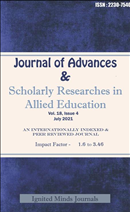Soybean (Glycine Max (l.) Merril) and its Biological Control – A Review
Keywords:
Glycine max (L.) Merril, Soybean, Oilseeds, MycofloraAbstract
The soybean (Glycine max (L.) Merril) is a commercially significant leguminous seed crop for feed and food applications, containing 40% seed protein and 20% oil. Among the major oil crops, soybean ranks first in world production in international trade markets, followed by cottonseed, groundnut (peanut), sunflower seed, rapeseed, linseed, sesame seed, and safflower. Many oilseed crops' seeds are known to have substantial mycoflora. Seed-borne microorganisms have a substantial influence on agricultural production in the field and reduce seed shelf life. Oilseeds are susceptible to fungal attack due to unsanitary storage conditions. The fungus degrades the grains both qualitatively and quantitatively. Numerous studies have been conducted to investigate the quantitative and qualitative characteristics of the oilseed seed mycoflora. The paper discusses the changes in seed contents caused by seed infection with seed-borne fungus. According to the current research, Glycine max seeds usually contain a variety of pathogenic fungus that can cause serious infections in the field.
Downloads
References
Agarwal, P.C., Majumdar, A., Usha Dev., Ramanatfa and Ketardal 1990. Seed borne fungi of quarantine importance in excoticgermplasam of soybean. Indian J. Agric. Sci. 60 (5); 361-363.
Agarwal, V.K. 1981. Seed borne fungi and viruses of some important crops. G.B. Pant University of Agriculture and Technology, Pantnagar (Nainital). Res. Bull. 108: 85-97.
Agrawal, V.K. and Singh, O.S. 1974. Fungi associated with sunflower seeds. Indian Phytopath. 17: 240. Ahmed, S.L, Khan, A.M. and Saxena, S.K. 1981. Mycoflora of cracked seeds of certain wheat varieties. Section of Agric. Sci., Indian Sci. Congress, 68 sessions.
Bhargava, K.S., Dixit, S.N., Dubey, N.K. and R.D. Tripatfai. 1981. J. Indian. Bot. Soc. 60: 24-27.
Bose, A. and Nandi, B. 1985. Role of enzymes of storage fungi in deterioration of stored sunflower and sesame seeds. Seed Res. 13(2): 19- 28.
Castor and Frederiksen, R.A. 1981. Seed transmission of Perenosclerosporasorghiin grain sorghum how can it be avoided. M.Sc. allaneous public. Texas Agile. Expt. Station No. 1453, pp. 8.
Das Gupta, M.K. 1977. Concept of disease in plant pathology and its applicability elsewhere. Phytopath Z. 88; 136-139. de Tempe, J. 1953. The blotter method ofseed health testing. Proc. Int. Seed Test. Asso. 28: 133-151.
Diener, U.L. 1959. Mold determination in stored farm stock peanut seeds and their relation to concealed damage. Phytopathology 37: 512-22.
Kanmanithi, K. 1996. Efficacy of fungicides in the control of powdery mildew of sesamum caused by Oidiumacanthospermi. Indian Journal of Mycology and Plant Pathology 26(2): 229-230.
Lalithakumari, D., Govii/daswami, C.V. and Vidhyasekaran, P. 1972. Isolation ofseed borne fungi from stared groundnut seed and their role in seed spoilage, madras Agric. Jr. 59 (1): 1-6.
Locher, R. and Bucheli, P. 1998. Comparison of soluble sugar degradation in soybean seed under simulated tropical storage conditions. Crop Science 38: 5, 1229-1235.
Nandi, D. Mandal, G.C. and Nandi, B. 1982. Studies on deterioration Of some oil seed in storage. Seed Sci and Tech., 10 (1): 141-150.
Nik, W. Z. (1980). Seed-borne Fungi of Soybean (Glycine max (L.) Merril) and their control. Pertanika, 3(2), 125-132.
Pimentel, I. C., Glienke-Blanco, C., Gabardo, J., Stuart, R. M., &Azevedo, J. L. (2006). Identification and colonization of endophytic fungi from soybean (Glycine max (L.) Merril) under different environmental conditions. Brazilian archives of biology and technology, 49, 705-711.
Pimentel, I. C., Glienke-Blanco, C., Gabardo, J., Stuart, R. M., &Azevedo, J. L. (2006). Identification and colonization of endophytic fungi from soybean (Glycine max (L.) Merril) under different environmental conditions. Brazilian archives of biology and technology, 49, 705-711.
Prasad, B.K. Rao, R.N., Narayan, N., Singh, R.N., Rahman, A., Singh, S.P., Dayal, S. and Shanker, U. 1990. Changes in sugar and amino acid content in stored radish seeds due to A. flavus. Indian Phytopath. 43(3): 457-458.
Rani, A.S. and Reddy, G.M. 1999. Isolation of phytoalexins from groundnut leaves produced in response to infection with Cercoporaarachidicola. Journal ofMycology and Plant Pathology 29: 100-102.
Singh, B.G., Kumar, A. and Kumar, S.S. 2001. Seed dormancy in oilseeds with spl. Ref. to sunflower A. Review. 18 122-128.
Singh. 1995. Seed heath studies of some advanced soybean cultivars. Indian. J. Myco. Plant. Pathol. 25 (3): 321-322.
Subramanyam, P. and Rao, A.S. 1976. Fungi associated with concealed damage ofgroundnut, Tran. Bri. Myc. Soc. 66 (3): 551-552.
Vaidya Anjail and Dharamvir. 1989. Changes in the oil in stored groundnut due to Aspergillus nigerand A. flavus. Indian Phytopath. 42 (4): 525-529.
Vijayalaxmi, M. and Rao, A.S. 1985. Fungi infection of sunflower heads under different conditions of storage. Ind. Phytopath. 38 (2); 315- 318.
Wasnikar, A.R., Sharma, S.M. and Prasad, K.V.V. 1987. Seed borne mycoflora ofsesamum and their significance. J. Oil seed Res. 4 (2): 41- 144.
Yadava, R.N. 1989. Invitro Antimicrobial Studies On theSaponin Obtained fromCaesalpiniasappanLinn. Asian Jr. OfChem. 1(1); 88- 89.
Zazzarni, A. and Buonaurio. R. 1981. Diseases ofsafflower. Leafspot due of Altermriasp. Melattie del cartamo.31 (11): 7-10.











